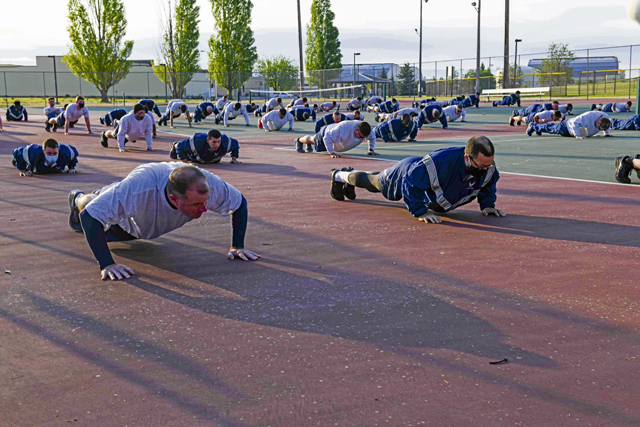
— Photo by Senior Airman Keifer Bowes
A new medical approach is being offered to Airmen and Guardians, which has shown to improve and sustain medical readiness and health by taking a more patient-driven, whole body approach to care.
The Air Force Medical Service endorsed the creation of Lifestyle and Performance Medicine to improve how providers address barriers to health. Currently, the new approach to health care is being formally offered at Travis Air Force Base, Whiteman Air Force Base, the U.S. Air Force Academy, and Wright-Patterson Air Force Base. However, the foundations of Lifestyle Medicine are currently being delivered by trained practitioners throughout the Air Force.
In July 2020, the Air Force Medical Service chartered a working group to address chronic disease from the readiness perspective.
“Providers across the Air Force were seeing chronic diseases that impacted the readiness of our Airmen and Guardians that weren’t being addressed through lifestyle foundations,” said Col. Mary Anne Kiel, Air Force Medical Home chief, Air Force Medical Readiness Agency. “We determined that we would be more effective in addressing those issues long term by collaborating within the Air Force to bring Lifestyle and Performance Medicine to the forefront of how we deliver care. That is when we initiated a formal working group last year to begin the process.”

What is lifestyle and performance medicine?
Lifestyle and performance medicine is the military’s adaptation of the existing, evidence-based Lifestyle Medicine sub-specialty, which is one of the fastest growing sub-specialties in medicine. Lifestyle and Performance Medicine adds the tactical component of human performance optimization to sustain warfighter medical readiness.
“To significantly improve the performance and readiness of our active duty members, we have incorporated the six pillars of Lifestyle Medicine – nutrition, sleep, physical activity, mental health stress reduction, avoidance of risky substances, and building social connection,” said Kiel.
As Kiel explains, the approach is a departure from the traditional way of treating patients by taking a holistic approach to care and addressing the root cause of health concerns. Care begins by addressing the patient’s personal health goals, identifying what is most important to the patient, and by developing a treatment plan that includes addressing the foundations of Lifestyle Medicine.
Providers across several medical specialties may work in partnership with the patient and can include providers like primary care, dietitians, exercise physiologists, physical therapists, behavioral health specialists, as well as other specialty providers who have training in Lifestyle Medicine.
“It is different than what we have done in the past where the primary care provider will see the patient, recommend the patient see a specialist who may not have any training in Lifestyle Medicine, and both providing a treatment plan that is more in line with conventional medicine. That patient may then see another provider who may also prescribe another treatment plan,” said Kiel. “We want providers speaking the same language about the treatment plan through Lifestyle Medicine foundations to better address the patient’s personal health goals. This new approach provides a more impactful way to sustain health and readiness.”
Having providers on the same page when it comes to a patient’s treatment plan is key to sustaining the long-term health of the patient.
“Through the Lifestyle and Performance Medicine approach, I can manage my patients’ health, help them actively reverse disease, and set the patients up for success,” said Maj. Regan Stiegmann, flight surgeon and Lifestyle and Performance Medicine physician, 10th Operational Medical Readiness Squadron at the U.S. Air Force Academy, Colorado. “We are not just treating the disease, but also reversing diseases and taking patients off medication because we are addressing the root cause of the chronic disease. We are not just slapping on a temporary pharmaceutical fix for disease symptoms. We actively work to address the core causes of chronic diseases, such as high cholesterol, high blood pressure, and pre-diabetes, so patients no longer have to rely on managing symptoms with medications.”

Impact on Airman and Guardian readiness
According to Kiel, this approach plays a vital role in readiness by addressing some of the biggest hurdles to deployability head on.
“People have a sense that active duty Airmen and Guardians are healthy because that’s our job,” said Kiel. “But we know our members are not as healthy as they could be. This is impacting their performance in a big way. We are also seeing these same health concerns among potential recruits. We not only want to recruit healthy individuals, we want to retain them. The Lifestyle and Performance Medicine approach can serve as a key way to address that.”
At the U.S. Air Force Academy, Stiegmann has seen various ways this approach has improved the lives of her patients, in addition to significantly improving their performance and ability to support the mission.
One of the key things she recommends to her patients is a shift to a predominantly whole food, plant-based diet.
“We see that when members increase their intake of vegetables, fruits, beans, legumes, nuts, and natural high-fiber foods, we are seeing improved optimization of their health in many ways,” said Stiegmann. “This food paradigm shift towards eating more plant-based foods leads to better control of weight, cholesterol, diabetes, and it can even help offset some of the contributors to dementia and many cancers.”
One of Stiegmann’s patients, Maj. Grant Scholl, the 70th Flying Training Squadron Operations Manager, initially came in for a consultation when he was dealing with health issues such as high cholesterol and pre-diabetes.
“I had always prided myself on eating right, working out and being all-around healthy, but seeing my labs and pre-diabetic indicators really shocked my conceptions of where I believed my health to be,” said Grant. “With a few minor changes to the way I eat, within three months, I was able to reset all of my health metrics well into the normal health investment zone range.”
Grant was able to reduce his bad cholesterol levels, reverse his pre-diabetes, lose weight, improve his energy levels and improve his sleep.
“I told [Grant] when he initially came in that I could address each of these issues separately with pharmaceuticals, which will only serve as a temporary, superficial fix. The other option was to change his diet,” said Stiegmann. “The greatest thing he achieved by adopting a predominantly plant-based diet is that it allowed his body to heal, which helped him put his pre-diabetes and high cholesterol diagnoses into remission.”
Many patients often believe they are taking the necessary steps to stay healthy and remain deployable. Patients are frequently shocked when they are met with lab values that indicate otherwise. This was the case for Maj. Chris Cherry with the 557th Flying Training Squadron.
“I never thought I’d have issues with high cholesterol,” said Cherry. “I thought I ate well enough, and had a good body weight. I have always been active — I even ran a Boston-qualifying marathon. So I was surprised to hear my cholesterol levels were high.”
After meeting with Stiegmann, Cherry noticed an improvement in his cholesterol levels while improving other aspects of his overall health and performance.
“After my annual flight physical last year, I decided to take control of my diet by eating almost an entirely plant-based diet and cutting out most processed foods,” said Cherry. I definitely just felt better. I had more energy, I felt more in control of my appetite, and I was experiencing more stability mentally and emotionally.”
For Cherry, this improvement was not just felt, but also seen in his lab results. His low-density lipoprotein, or LDL cholesterol levels, lowered from 225 to 178 when he moved away from a high fat diet. His LDL levels lowered a year after that to 136 when he reduced the amounts of animal products and processed foods he consumed. His LDL levels then dropped down to 115 after a week of going on a completely whole food, plant-based diet.
“I’m not saying everyone needs to cut out all animal products and processed foods, but in my experience, the more closely I’ve adhered to a whole-food, plant-based diet, the better I’ve felt and the lower my LDL levels have dropped.”
Not only can this approach provide steps patients can take to improve their overall health, they also work on addressing causes of poor health and barriers to changing health outcomes.
“When we look at the patient from a multi-angled perspective, we start seeing if, for example, a patient has an emotional relationship with food or if they are prone to binge eating when stressed,” said Stiegmann. “In partnering with behavioral health specialists, we can help the patient re-assess and truly process how they developed this relationship with food and better help the patient achieve long-term health goals and outcomes.”
Additionally, Lifestyle and Performance Medicine providers can help identify environmental contributors that could negatively impact a patient’s health. As Kiel explains, providers can work with the patient to address sources of stress and some of the social and workplace challenges so they can make healthier choices in the long run.
“We have suggested that patients keep go-to healthy snack options nearby to avoid going to the vending machine,” said Kiel. “We have also suggested patients spend some time each day to practice mindfulness or meditation, take a short walk on their lunch break to de-stress, prepare their bedroom to improve their sleep quality, set up a bedtime routine to wind down, and decrease screen time.”

Health care culture shift
While relatively new, the implementation of Lifestyle and Performance Medicine has led to consistent improvements in the patients who have received consultations. For Stiegmann, adoption throughout the Military Health System will lead to necessary changes in health care culture.
“We have to look beyond a disease management system to promote and practice true health maintenance with our patients,” said Stiegmann. “This is what health sustainability actually looks like. We have to change the dialogue we have with our patients and give them the option to become active participants in their own health.”
Kiel eventually wants to see this approach grow across the Department of Defense.
“We are partnering with other clinics and our graduate medical education programs to train our physicians, nurses and allied health providers in the foundations of Lifestyle and Performance Medicine,” said Kiel. “Over time, we can integrate Lifestyle Medicine foundations in military domains outside of the medical arena, such as in military training programs, workplace environments and military installations. This emphasis on human performance can then become the way we approach our military personnel and be more accessible to our service members.
“This will be a long-term endeavor, but necessary to improve the health of our warfighters,” said Stiegmann. “Lifestyle and Performance Medicine will not only lead to higher numbers of deployment-ready service members, but we are going to be greatly reducing the chronic disease burden and side-effects that are so prevalent among many Americans in uniform. We are going to see healthier, happier service members who are stronger and better able to support the mission.”


